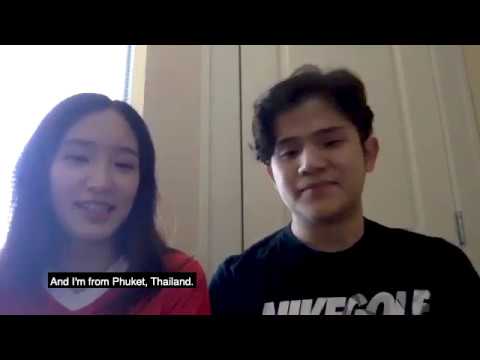Anupras Mohapatra remembers the cusp of the COVID-19 pandemic clearly.
It was a Wednesday morning, he recalled, when he received a notification that quickly changed everything: students would not be allowed to return to their residence halls at UW-Madison. As an international student from the United Arab Emirates, that meant he’d either have to hop on a 16-hour flight home or request a waiver to stay in Madison — alone. He opted to remain on campus, where he’s now stuck in the U.S. indefinitely.
Though Mohapatra is in isolation, he isn’t alone in this kind of experience. As many countries have now closed their borders and limited travel, international students across the nation are facing the unique burden of social distancing while thousands of miles from home. To many, the circumstances are even more challenging amid a pandemic that has exacerbated already-existing xenophobia and discrimination.
Hazel Tang is one such UW international student who has faced this issue. In her home country of China, where nearly 370,000 international students in the U.S. come from, the government has placed heavy restrictions on travel. She said tickets to purchase a flight home have reached upwards of $10,000, making a flight out of reach for many students in her situation. Even if she were to head home, she said, it may be even harder to return to the U.S. in the future.
“We have to decide whether we should go home with a risk, and even if we go back, what if we cannot go into the U.S. later?” Tang said. “It’s totally a dilemma for us to decide whether we should stay in the United States and probably be victims of anti-Asian crime or to go home and not have a chance to continue to study.”
Tang’s worries of discrimination are not unfounded. According to a poll conducted by the New Center for Public Integrity (NCPI), more than 30% of Americans have witnessed someone blaming people of Asian descent for the pandemic. That number jumps to 60% among Asian Americans who took the survey.
One out of 4 people also said they would be concerned about coming into close contact with an Asian person in public.
Tang said that sentiment is especially concerning in Wisconsin. In April, the sidewalks of State Street in Madison were chalked with ‘It’s from China #ChineseVirus’ and ‘Fuck the Chinese government.’ When Tang’s friend denounced the anti-Chinese acts on social media, she was bombarded with comments and messages attacking her.

The coronavirus outbreak originally began in Wuhan, China, but a recent preprint study found that the first COVID-19 cases in New York City — the epicenter of the U.S. coronavirus outbreak — originated in Europe. The researchers found little evidence of transmission in New York from China or other Asian countries.
Still, among the respondents in NCPI’s study who said specific organizations or people were to blame for the pandemic, two-thirds labeled China or Chinese people as the culprit in particular. Considering many people find it difficult to distinguish between different Asian ethnicities, this condemnation is one that frightens Chinese people and non-Chinese Asians alike.
“We just feel like it’s not really safe to live in Madison even though this is our only home right now,” Tang said. “I literally feel threatened by people … what if I die from this instead of the virus?”
Others also referenced incidences of racism and harassment in the city. Jamie Lam, a UW international student from Thailand, said strangers have made derogatory statements about Chinese people to her and her friends. Because of increased reports of hate crimes against Asians, as well as anti-Chinese rhetoric espoused by President Donald Trump, Lam said she is afraid to go out in public.
“Any time I’m going outside, I’ll take a roommate with me just in case something happens,” she said. “The sad part is that … we have to run through a scenario in case you run into an assault or something: what we’re going to do or what we’re going to say, and how are we going to handle everything in case it escalated into something very physical.”
This type of harassment seems to be a current trend in the U.S. In fact, the FBI recently warned of a potential surge in hate crimes against Asian Americans, and researchers found that the pandemic has corresponded with an increase in anti-Chinese sentiments posted online.
Stop AAPI Hate — a website which tracks discrimination against Asian Americans and Pacific Islanders during the pandemic — also reported nearly 1,500 incidents of harassment from March to April. According to the organization, microaggressions like name-calling and verbal harassment were among the most commonly reported cases.
In the organization’s press release, Cynthia Choi — co-executive director of Chinese for Affirmative Action — said the reported cases are only a “snapshot” of what Asian Americans face on a daily basis. The amount of anti-Asian harassment is likely to be even larger than what has been tracked so far, she said.
“We can expect the situation to worsen as the anti-China, anti-Chinese rhetoric becomes normalized,” Choi said. “We know too well how this will all play out — fear mongering and xenophobia will lead to more attacks against AAPIs.”
In fact, this type of prejudice is nothing new for Asian communities. Asian Americans have long been perceived as ‘perpetual foreigners,’ an idea which suggests that Asians who live in the U.S. can never be truly American. That sentiment has othered them for centuries, leading to policies like the Chinese Exclusion Act — which banned Chinese immigrants from entering the U.S. in the 1800s — and Japanese internment during World War II — which resulted in the mass incarceration of 120,000 Japanese Americans in the 1940s.
“I think because of both COVID-19 and the problem of racism that exists in society, it has brought out the worst in people here,” said Neal Pongmorrakot, a UW student from Thailand.
Lam, who is also Pongmorrakot’s roommate, added, “This is the biggest curtain reveal on our social structure, financial structure and healthcare structure. We’re far beyond being prepared for this.”
While the pandemic and Trump’s rhetoric can certainly be attributed to the recent surge of anti-Asian discrimination, biases toward Asian Americans have persisted for many generations. This health crisis has only added fuel to the fire.
“I feel like Trump is trying to scapegoat China for his own incapacity to find a solution for this pandemic,” Tang said. “But there’s this cycle of racism being normalized among people in the U.S, like the government, the media and every individual.”
Pongmorrakot, Lam, Tang and Mohapatra all shared that their mental health has suffered due to the pandemic. The students’ said their anxieties stem from fear of physical and verbal harassment, as well as the stress of online classes, job cancellations and the inability to safely return home.
“There’s always an element of that kind of worry and anxiety because you’re so far away, and the situation’s evolving every day,” Mohapatra said. Lam added that she has depression disorder, which has worsened in the past few months as her travel plans have continued to change.
In Thailand, the government imposed a ‘fit-to-fly’ policy for entrance into the country. It requires certain travelers — including Thai citizens — to present a letter which verifies they have health insurance that covers COVID-19, as well as a doctor’s clearance no later than 72 hours before boarding their flight. The government also only allows 300 people to cross the Thai borders per day.
Referencing barriers like these, as well as increased hate toward Asian Americans, the four students said there is no ‘better option’ for them. That leaves them in limbo during the pandemic, where they are stuck in the U.S. for the unforeseeable future.
“I have no way of predicting this at all,” Mohapatra said. “People don’t know what’s going to happen. Everything is up in the air.”















































